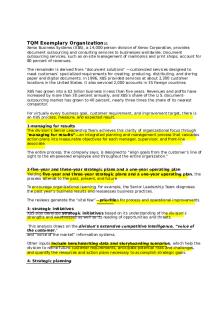Executive Summary – Horniman Horticulture Case Study PDF

| Title | Executive Summary – Horniman Horticulture Case Study |
|---|---|
| Author | Obaid khan |
| Course | Corporate Finance |
| Institution | Kabul University |
| Pages | 2 |
| File Size | 64.7 KB |
| File Type | |
| Total Downloads | 22 |
| Total Views | 132 |
Summary
It is the case study....
Description
Executive Summary – Horniman Horticulture Case Study Problem definition: Horniman Horticulture ended up with a liquidity problem, because most of their cash was tied up in inventory and accounts receivable. Relevant facts: Although Horniman Horticulture’s profits have grown rapidly over the past three years, contrarily, their cash on hand has been decreasing to a point less than their target level of 8% of annual revenue in 2005. They’ve done quite successfully at driving revenue up and exceeding profits higher than the industry average, but are experiencing a cash flow problem due to their business model. If this is not dealt with now, they’ll face the potential of bankruptcy in the future, especially with their approaching acquisition of land next year which they don’t plan to finance. Analysis: Looking at Exhibit A, which gives the projection for 2006. As local economy is growing, demand is going to continue to grow in their business. Most of their inventory will be ready for customers, resulting in Bob’s estimation of 30% increase in their revenue growth and to reach $1,363,400 in 2006. During 2002 to 2005, they are greatly increasing sales (15.5% in 2005), net profit, total assets and have a high ROE (5.1% in 2005) (see Exhibit B). While maintaining relatively stabilized depreciation and tax expenses, they are relaxed on their accounts receivable and credit terms. Since Horniman Horticulture is making payments to suppliers within 10 days to obtain trade discounts, and is only collecting accounts receivables every 50.9 days, this illustrates how the Browns are making payments 5 times faster than they are receiving them. They pay their cash greatly faster at 9.9-day than the benchmark of 26.9-day. Besides, their inventory are not being turned over as often and has actually continued to increase since the beginning of the business (424.2-day in 2002 to 476.3-day in 2005, the benchmark in 2005 is 386.3-day) (see Exhibit B). They are holding their inventory longer, collecting receivables slower and paying out cash faster, all together these destroy their cash balance. Their liquidity ratios (see Exhibit C) for 2002 to 2005 (and 2006 projected) are all diminishing, cash has significantly decreased the most.
The business as a whole is running quite strongly and their main problem is the diminishing cash flow. To solve this issue, the option is not to pay their suppliers within the 10-day period to obtain the 2% savings, thus to avoid the scenario that their cash outflows are paid 5 times faster than their cash inflows. If they increase the accounts payable to 30-day, they could see a massive change in their short-term liquidity status. They could also implement a preferred customer promotion policy for customers with large orders or customers who always pay early to promote timely collection of accounts receivable. Regarding their capital expenditure on acquisition the next year, they should think about taking a bank loan to finance this $75,000 asset investment. This would save them a huge amount in 2006 instead of paying it with cash they don’t have. Recommendations: They should figure out their cash problem by fixing their accounts payable at 30-day to see the improvement on cash flow. Meanwhile they should decrease account receivable days to tie it with the accounts payable to balance cash outflows and inflows. Maggie should also consider the option of a bank loan based on the calculation of their growth and profit rates....
Similar Free PDFs

Executive Summary
- 8 Pages

EXECUTIVE SUMMARY
- 102 Pages

EXECUTIVE SUMMARY
- 175 Pages

Executive summary
- 3 Pages

Executive Summary CHLH
- 4 Pages

Executive Summary - Very Simple
- 4 Pages

Executive summary technical
- 7 Pages

Executive Summary TRussum
- 2 Pages

Executive Summary- Acaml
- 20 Pages

EXECUTIVE SUMMARY STRAMAN
- 7 Pages

ENT526 Executive Summary
- 6 Pages

Executive Branch Study Guide
- 2 Pages

Case study summary
- 2 Pages
Popular Institutions
- Tinajero National High School - Annex
- Politeknik Caltex Riau
- Yokohama City University
- SGT University
- University of Al-Qadisiyah
- Divine Word College of Vigan
- Techniek College Rotterdam
- Universidade de Santiago
- Universiti Teknologi MARA Cawangan Johor Kampus Pasir Gudang
- Poltekkes Kemenkes Yogyakarta
- Baguio City National High School
- Colegio san marcos
- preparatoria uno
- Centro de Bachillerato Tecnológico Industrial y de Servicios No. 107
- Dalian Maritime University
- Quang Trung Secondary School
- Colegio Tecnológico en Informática
- Corporación Regional de Educación Superior
- Grupo CEDVA
- Dar Al Uloom University
- Centro de Estudios Preuniversitarios de la Universidad Nacional de Ingeniería
- 上智大学
- Aakash International School, Nuna Majara
- San Felipe Neri Catholic School
- Kang Chiao International School - New Taipei City
- Misamis Occidental National High School
- Institución Educativa Escuela Normal Juan Ladrilleros
- Kolehiyo ng Pantukan
- Batanes State College
- Instituto Continental
- Sekolah Menengah Kejuruan Kesehatan Kaltara (Tarakan)
- Colegio de La Inmaculada Concepcion - Cebu


